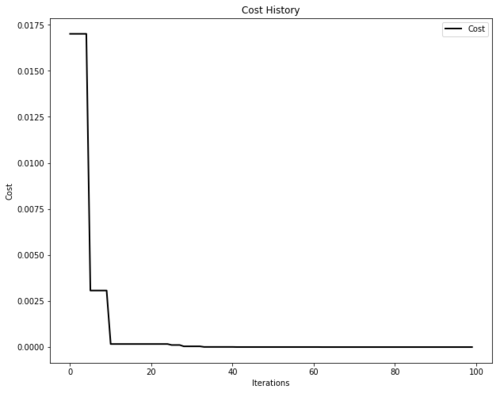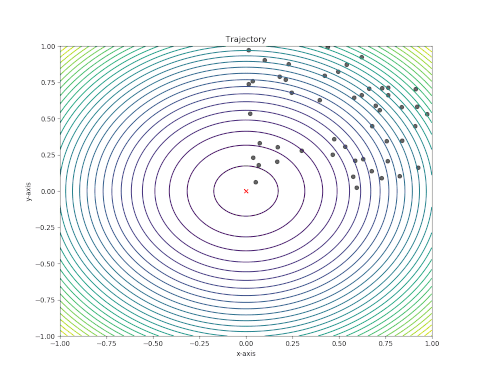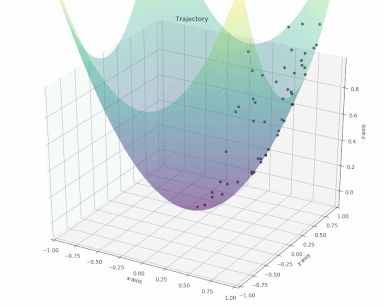A Python-based Particle Swarm Optimization (PSO) library.
Project description
PySwarms is an extensible research toolkit for particle swarm optimization (PSO) in Python.
It is intended for swarm intelligence researchers, practitioners, and students who prefer a high-level declarative interface for implementing PSO in their problems. PySwarms enables basic optimization with PSO and interaction with swarm optimizations. Check out more features below!
| Branch | Status | Documentation | Description |
|---|---|---|---|
| master |  |
 |
Stable, official PyPI version |
| development |  |
 |
Bleeding-edge, experimental |
- Free software: MIT license
- Documentation: https://pyswarms.readthedocs.io.
- Python versions: 3.4 and above
Features
- High-level module for Particle Swarm Optimization. For a list of all optimizers, check this link.
- Built-in objective functions to test optimization algorithms.
- Plotting environment for cost histories and particle movement.
- Hyperparameter search tools to optimize swarm behaviour.
- (For Devs and Researchers): Highly-extensible API for implementing your own techniques.
Dependencies
- numpy >= 1.13.0
- scipy >= 0.17.0
- matplotlib >= 1.3.1
Installation
To install PySwarms, run this command in your terminal:
$ pip install pyswarms
This is the preferred method to install PySwarms, as it will always install the most recent stable release.
In case you want to install the bleeding-edge version, clone this repo:
$ git clone -b development https://github.com/ljvmiranda921/pyswarms.git
and then run
$ cd pyswarms
$ python setup.py install
Basic Usage
PySwarms provides a high-level implementation of various particle swarm optimization algorithms. Thus, it aims to be user-friendly and customizable. In addition, supporting modules can be used to help you in your optimization problem.
Optimizing a sphere function
You can import PySwarms as any other Python module,
import pyswarms as ps
Suppose we want to find the minima of f(x) = x^2 using global best
PSO, simply import the built-in sphere function,
pyswarms.utils.functions.sphere_func(), and the necessary optimizer:
import pyswarms as ps
from pyswarms.utils.functions import single_obj as fx
# Set-up hyperparameters
options = {'c1': 0.5, 'c2': 0.3, 'w':0.9}
# Call instance of PSO
optimizer = ps.single.GlobalBestPSO(n_particles=10, dimensions=2, options=options)
# Perform optimization
best_cost, best_pos = optimizer.optimize(fx.sphere_func, iters=100, verbose=3, print_step=25)
>>> 2017-10-03 10:12:33,859 - pyswarms.single.global_best - INFO - Iteration 1/100, cost: 0.131244226714
>>> 2017-10-03 10:12:33,878 - pyswarms.single.global_best - INFO - Iteration 26/100, cost: 1.60297958653e-05
>>> 2017-10-03 10:12:33,893 - pyswarms.single.global_best - INFO - Iteration 51/100, cost: 1.60297958653e-05
>>> 2017-10-03 10:12:33,906 - pyswarms.single.global_best - INFO - Iteration 76/100, cost: 2.12638727702e-06
>>> 2017-10-03 10:12:33,921 - pyswarms.single.global_best - INFO - ================================
Optimization finished!
Final cost: 0.0000
Best value: [-0.0003521098028145481, -0.00045459382339127453]
This will run the optimizer for 100 iterations, then returns the best cost
and best position found by the swarm. In addition, you can also access
various histories by calling on properties of the class:
# Obtain the cost history
optimizer.get_cost_history
# Obtain the position history
optimizer.get_pos_history
# Obtain the velocity history
optimizer.get_velocity_history
At the same time, you can also obtain the mean personal best and mean neighbor
history for local best PSO implementations. Simply call mean_pbest_history
and optimizer.get_mean_neighbor_history respectively.
Hyperparameter search tools
PySwarms implements a grid search and random search technique to find the
best parameters for your optimizer. Setting them up is easy. In this example,
let's try using pyswarms.utils.search.RandomSearch to find the optimal
parameters for LocalBestPSO optimizer.
Here, we input a range, enclosed in tuples, to define the space in which the
parameters will be found. Thus, (1,5) pertains to a range from 1 to 5.
import numpy as np
import pyswarms as ps
from pyswarms.utils.search import RandomSearch
from pyswarms.utils.functions import single_obj as fx
# Set-up choices for the parameters
options = {
'c1': (1,5),
'c2': (6,10),
'w': (2,5),
'k': (11, 15),
'p': 1
}
# Create a RandomSearch object
# n_selection_iters is the number of iterations to run the searcher
# iters is the number of iterations to run the optimizer
g = RandomSearch(ps.single.LocalBestPSO, n_particles=40,
dimensions=20, options=options, objective_func=fx.sphere_func,
iters=10, n_selection_iters=100)
best_score, best_options = g.search()
This then returns the best score found during optimization, and the hyperparameter options that enables it.
>>> best_score
1.41978545901
>>> best_options['c1']
1.543556887693
>>> best_options['c2']
9.504769054771
Swarm visualization
It is also possible to plot optimizer performance for the sake of formatting.
The plotters moule is built on top of matplotlib, making it
highly-customizable.
import pyswarms as ps
from pyswarms.utils.functions import single_obj as fx
from pyswarms.utils.plotters import plot_cost_history
# Set-up optimizer
options = {'c1':0.5, 'c2':0.3, 'w':0.9}
optimizer = ps.single.GlobalBestPSO(n_particles=50, dimensions=2, options=options)
optimizer.optimize(fx.sphere_func, iters=100)
# Plot the cost
plot_cost_history(optimizer.cost_history)
plt.show()
We can also plot the animation...
from pyswarms.utils.plotters.formatters import Mesher
from pyswarms.utils.plotters.formatters import Designer
# Plot the sphere function's mesh for better plots
m = Mesher(func=fx.sphere_func)
# Adjust figure limits
d = Designer(limits=[(-1,1), (-1,1), (-0.1,1)],
label=['x-axis', 'y-axis', 'z-axis'])
In 2D,
plot_contour(pos_history=optimizer.pos_history, mesher=m, mark=(0,0))
Or in 3D!
pos_history_3d = m.compute_history_3d(optimizer.pos_history) # preprocessing
animation3d = plot_surface(pos_history=pos_history_3d,
mesher=m, designer=d,
mark=(0,0,0))
Contributing
PySwarms is currently maintained by a small yet dedicated team:
- Lester James V. Miranda (@ljvmiranda921)
- Siobhán K. Cronin (@SioKCronin)
- Aaron Moser (@whzup)
And we would appreciate it if you can lend a hand with the following:
- Find bugs and fix them
- Update documentation in docstrings
- Implement new optimizers to our collection
- Make utility functions more robust.
We would also like to acknowledge all our contributors, past and present, for making this project successful!
If you wish to contribute, check out our contributing guide. Moreover, you can also see the list of features that need some help in our Issues page.
Most importantly, first time contributors are welcome to join! I try my best to help you get started and enable you to make your first Pull Request! Let's learn from each other!
Credits
This project was inspired by the pyswarm module that performs PSO with
constrained support. The package was created with Cookiecutter and the
audreyr/cookiecutter-pypackage project template.
This is currently maintained by Lester James V. Miranda with other helpful contributors:
- Carl-K (
@Carl-K) - Siobhán Cronin (
@SioKCronin) - Andrew Jarcho (
@jazcap53) - Charalampos Papadimitriou (
@CPapadim) - Mamady Nabé (
@mamadyonline) - Erik (
@slek120) - Thomas (
@ThomasCES)
Cite us
Are you using PySwarms in your project or research? Please cite us!
- Miranda L.J., (2018). PySwarms: a research toolkit for Particle Swarm Optimization in Python. Journal of Open Source Software, 3(21), 433, https://doi.org/joss.00433
@article{pyswarmsJOSS2018,
author = {Lester James V. Miranda},
title = "{P}y{S}warms, a research-toolkit for {P}article {S}warm {O}ptimization in {P}ython",
journal = {Journal of Open Source Software},
year = {2018},
volume = {3},
issue = {21},
doi = {10.21105/joss.00433},
url = {https://doi.org/10.21105/joss.00433}
}
Projects citing PySwarms
Not on the list? Ping us in the Issue Tracker!
- Gousios, Georgios. Lecture notes for the TU Delft TI3110TU course Algorithms and Data Structures. Accessed May 22, 2018. http://gousios.org/courses/algo-ds/book/string-distance.html#sop-example-using-pyswarms.
- Nandy, Abhishek, and Manisha Biswas., "Applying Python to Reinforcement Learning." Reinforcement Learning. Apress, Berkeley, CA, 2018. 89-128.
- Benedetti, Marcello, et al., "A generative modeling approach for benchmarking and training shallow quantum circuits." arXiv preprint arXiv:1801.07686 (2018).
- Vrbančič et al., "NiaPy: Python microframework for building nature-inspired algorithms." Journal of Open Source Software, 3(23), 613, https://doi.org/10.21105/joss.00613
Others
Like it? Love it? Leave us a star on Github to show your appreciation!
Project details
Release history Release notifications | RSS feed
Download files
Download the file for your platform. If you're not sure which to choose, learn more about installing packages.
Source Distribution
Built Distribution
Hashes for pyswarms-0.3.0-py2.py3-none-any.whl
| Algorithm | Hash digest | |
|---|---|---|
| SHA256 | 3917aa0aa00d0cc322922ef69f9036d4e8af3302ac2c66789d5d9b015f6a4fc1 |
|
| MD5 | 8503d8df31022b2e09158f243812e48c |
|
| BLAKE2b-256 | 205f2adb6f084e81337198d80985dd4d2308c10d6cfa9dcac617ad33f71da2d4 |




















